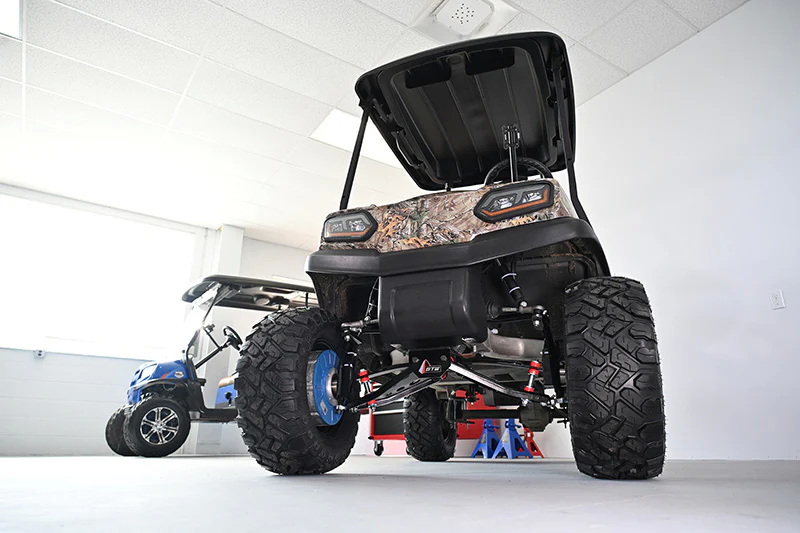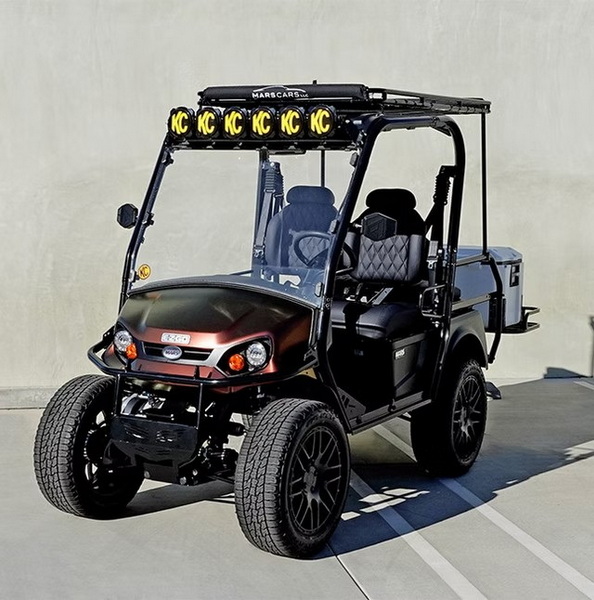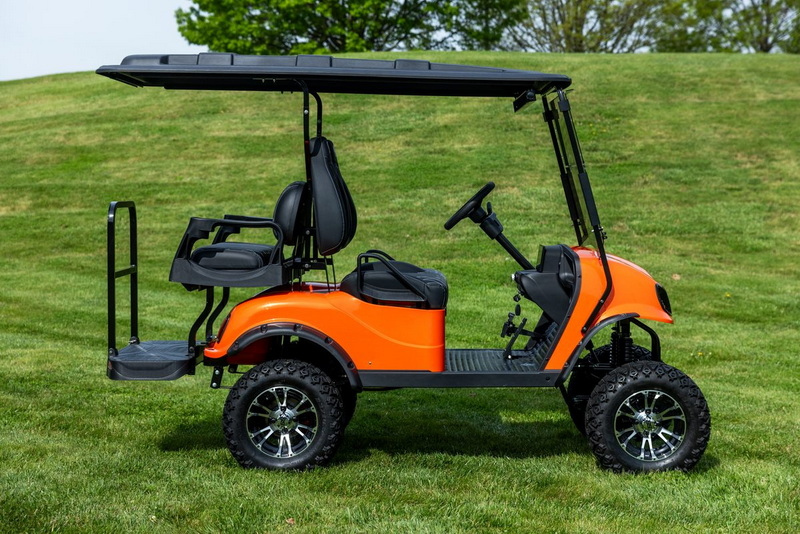Content Menu
● Gather Your Materials and Tools
● Disassemble the Base Cart
● Install the Electric Motor
● Set Up the Battery System
● Incorporate Drivetrain Components
● Upgrade Suspension and Tires
● Wiring and Electrical Components
● Test Your Golf Cart
● Additional Considerations
● Custom Features
● Maintenance Tips for Your Electric Golf Cart
● Troubleshooting Common Issues
● Conclusion
● FAQ
>> 1. What type of motor should I use for my electric golf cart?
>> 2. How long do lithium batteries last in an electric golf cart?
>> 3. Can I convert an existing gas golf cart into an electric one?
>> 4. What is the best way to enhance off-road performance?
>> 5. Is it necessary to consult professionals when building my cart?
Building an electric 4x4 golf cart is an exciting project that combines engineering skills with creativity. Whether you want to use it for off-roading, hunting, or simply cruising around your property, a custom-built electric golf cart offers flexibility and personalization. This guide will walk you through the steps necessary to create your own 4x4 electric golf cart, including essential components, assembly instructions, and tips for success.

Gather Your Materials and Tools
Before diving into the construction process, it's important to gather all necessary materials and tools. Here's a checklist to get you started:
- Base Golf Cart: A sturdy frame is essential. You can choose a used golf cart or build one from scratch using a metal frame.
- Electric Motor: Select a high-torque electric motor that provides sufficient power for off-road capabilities. Motors typically range from 5 to 20 horsepower.
- Battery System: Choose a battery pack that offers adequate range and power. Lithium batteries are preferred for their lightweight and long-lasting capabilities.
- Drivetrain Components: Incorporate a transfer case or differential system to distribute power to all four wheels effectively.
- Suspension Components: Upgrade the suspension with shocks and springs to enhance off-road performance.
- Aggressive Tread Tires: Select tires designed for rough terrain.
- Wiring Harness: For connecting electrical components.
- Basic Tools: Wrenches, screwdrivers, drill, welding equipment (if needed), etc.
Disassemble the Base Cart
If you are using an existing golf cart, start by disassembling it. Remove unnecessary parts such as:
- Gasoline engine (if applicable)
- Body panels
- Old wiring
Clean the frame thoroughly to ensure a good foundation for your new build. This step is crucial as it allows you to inspect the frame for any damage or rust that may need repair before proceeding.
Install the Electric Motor
Mount the electric motor in a secure location on the frame. Ensure that it is aligned properly with the drivetrain components. Use bolts and brackets to secure it firmly in place.
When selecting a location for the motor, consider factors such as weight distribution and accessibility for maintenance. The motor should be positioned low in the frame to lower the center of gravity, which improves stability during operation.
Set Up the Battery System
Choose a high-capacity battery pack that can supply enough energy to power the electric motor. Determine the best location for the battery pack on the cart and securely mount it. Connect the batteries according to your wiring diagram, ensuring proper voltage and polarity.
For optimal performance, consider using a battery management system (BMS) to monitor battery health and prevent overcharging or excessive discharging. This system can significantly extend the lifespan of your batteries.
Incorporate Drivetrain Components
Install a transfer case or differential system. This component is crucial for distributing power to all four wheels effectively. Ensure that all driveshafts are connected correctly and that there are no obstructions in movement.
A well-designed drivetrain will enhance traction on uneven surfaces, making your golf cart more capable in off-road conditions. Consider using heavy-duty components designed specifically for off-road applications.

Upgrade Suspension and Tires
Install upgraded shocks and springs to enhance off-road capability. Choose tires with deep treads designed for rough terrain. Proper tire pressure is essential for optimal performance; under-inflated tires can lead to poor handling while over-inflated tires may reduce traction.
When selecting tires, consider their size relative to your cart's frame and weight capacity. Larger tires can improve ground clearance but may require adjustments to the suspension system.
Wiring and Electrical Components
Connect all electrical components, including lights, indicators, and any additional features you plan to include (like sound systems). Ensure that all wiring is neatly organized and secured away from moving parts.
Use heat-shrink tubing or electrical tape to protect connections from moisture and dirt, which can lead to corrosion over time. A clean wiring job not only looks better but also reduces the risk of electrical failures.
Test Your Golf Cart
Before taking your new golf cart out for a spin, conduct thorough testing:
- Check all electrical connections.
- Test motor functionality.
- Ensure brakes are working properly.
- Verify that all components are securely attached.
Perform test runs in a controlled environment before venturing into rough terrain. Pay attention to how the cart handles different surfaces and make adjustments as necessary.
Additional Considerations
When building your 4x4 electric golf cart, there are several additional factors to consider:
- Weight Distribution: Proper weight distribution is crucial for stability and handling. Make sure that heavy components like batteries are placed low in the frame to lower the center of gravity.
- Local Regulations: Check local regulations regarding vehicle modifications and usage before taking your electric golf cart on public roads or trails.

Custom Features
Once you have built the basic structure of your golf cart, consider adding custom features such as:
- Sound Systems: Enhance your riding experience with Bluetooth speakers or integrated audio systems.
- Custom Paint Jobs: Personalize your cart's appearance with unique colors or graphics.
- Storage Solutions: Add compartments or racks for carrying gear or personal items.
- LED Lighting: Install LED lights for better visibility during nighttime use or in low-light conditions.
- Winch System: Consider adding a winch if you plan on using your cart in rugged terrain where getting stuck might be an issue.
Maintenance Tips for Your Electric Golf Cart
To ensure longevity and optimal performance of your electric golf cart, regular maintenance is essential:
1. Battery Care: Regularly check battery connections for corrosion and ensure they are charged properly. Follow manufacturer guidelines on charging cycles.
2. Tire Maintenance: Inspect tires frequently for wear and tear; maintain proper inflation levels to avoid flats or blowouts.
3. Electrical Checks: Periodically inspect wiring for frays or damage, especially after extensive use in rugged conditions.
4. Cleaning: Keep the cart clean by washing it regularly to remove dirt and debris that may accumulate during use.
5. Lubrication: Lubricate moving parts such as wheel bearings and suspension joints to prevent wear over time.
6. Software Updates: If your electric golf cart has a digital display or controller with firmware updates available, ensure these are kept up-to-date for optimal performance.
Troubleshooting Common Issues
Even with proper maintenance, issues may arise during operation:
- Motor Not Starting: Check battery charge levels and connections first; ensure that there's no blown fuse in the circuit.
- Poor Performance: If acceleration is sluggish or top speed is reduced, inspect tire pressure and battery health.
- Electrical Failures: If lights or accessories fail intermittently, check wiring connections for corrosion or loose fittings.
- Overheating Issues: If the motor overheats during operation, ensure it has adequate ventilation and isn't overloaded beyond its rated capacity.
Conclusion
Building an electric 4x4 golf cart can be a rewarding experience that allows you to create a vehicle tailored to your specific needs. By following these steps and considering important factors such as motor selection, battery capacity, weight distribution, drivetrain configuration, aesthetic customizations, performance enhancements, maintenance practices, troubleshooting common issues, and safety regulations; you can successfully construct a custom electric golf cart capable of tackling various terrains while providing an eco-friendly mode of transportation.

FAQ
1. What type of motor should I use for my electric golf cart?
For off-road capabilities, choose a high-torque electric motor ranging from 5 to 20 horsepower depending on your desired speed and terrain type.
2. How long do lithium batteries last in an electric golf cart?
Lithium batteries typically last between 5 to 10 years with proper maintenance and care, offering better longevity compared to lead-acid batteries.
3. Can I convert an existing gas golf cart into an electric one?
Yes, converting a gas golf cart into an electric one is feasible by removing the gas engine and installing an electric motor along with a battery system.
4. What is the best way to enhance off-road performance?
Upgrading suspension components (shocks/springs) and using aggressive tread tires will significantly enhance off-road performance of your golf cart.
5. Is it necessary to consult professionals when building my cart?
While not strictly necessary, consulting professionals can provide valuable insights and ensure safety during installation of electrical components and modifications.











































